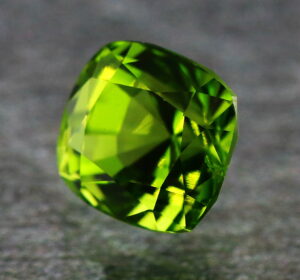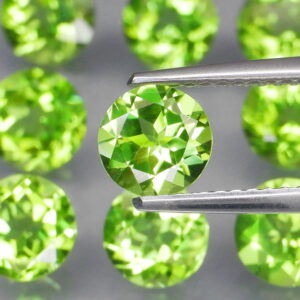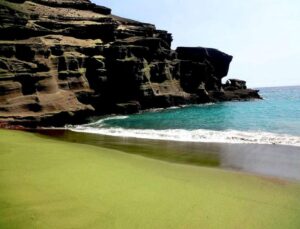Peridot: A Mislabeled August Birthstone
Peridot, also sometimes referred to as chrysolite,  is a form of the mineral olivine with a deep yellowish green hue. It is one of the few gemstones that only occurs in one color! The intensity and tint of its hue is dependent on the level of iron content, with variants going from a light greenish-yellow all the way to a brownish-green. Peridot has been mistaken for several other gems throughout its history, but this olive-colored beauty has become a staple in the gemstone and jewelry worlds taking its place as the official August birthstone.
is a form of the mineral olivine with a deep yellowish green hue. It is one of the few gemstones that only occurs in one color! The intensity and tint of its hue is dependent on the level of iron content, with variants going from a light greenish-yellow all the way to a brownish-green. Peridot has been mistaken for several other gems throughout its history, but this olive-colored beauty has become a staple in the gemstone and jewelry worlds taking its place as the official August birthstone.
Ancient Egyptians mined peridot on the Red Sea Island of Zabargad, which is the source for many of the world’s museums specimens. Legend has it that this island was snake infested, making it difficult to mine until a pharaoh drove the snakes into the sea. They called peridot the “gem of the sun,” which makes sense why it is believed to protect against negativity and drives away fears and nightmares. In rare occasions, peridot can be found in meteorites that fall to the earth. These tend to be the more expensive examples and are generally placed in museums or showcases. Some people believe that peridot carries the gift of “inner radiance,” allowing the mind to open to new levels of awareness and growth and helping to realize one’s destiny and spiritual purpose. It is also considered a warm and joyful gem that can ease anger and jealousy.
It is also considered a warm and joyful gem that can ease anger and jealousy.
Peridot has been mislabeled throughout history and from the earliest times, people confused it with different gem types. It was one of the many stones labeled originally as “topaz” and has also been mistaken for emeralds on many occasions. The most well-known example is the “Three Magi” treasure in the Dom of Cologne, where for centuries what they thought were emeralds adorning the shrine, are actually peridot. In fact, many church treasures included peridot in confusion with emeralds. Cleopatra laid claim to the oldest source of peridot in the world, which explains why much of her prized emerald collection actually turned out to be peridot. Luckily it was well after her reign that this was discovered so no one had to tell her!
 While you can find peridot jewelry and gems fairly easily in a store or on your computer, if you want to try and find some in the wild, there is a place that you can go! Papakōlea Beach is a green sand beach located near South Point, in the Kaʻū district of Hawaii. It gets its distinctive green coloring from olivine filled sand that erodes out of the volcanic tuff ring surrounding the beach. Since olivine is a common mineral component of lava and is one of the first crystals to form as the magma cools, it tends to accumulate on the beach while its less dense volcanic sand is swept out to sea. Olivine is known locally as the “Hawaiian Diamond” and is notably found in Oʻahu’s famous Diamond Head landmark.
While you can find peridot jewelry and gems fairly easily in a store or on your computer, if you want to try and find some in the wild, there is a place that you can go! Papakōlea Beach is a green sand beach located near South Point, in the Kaʻū district of Hawaii. It gets its distinctive green coloring from olivine filled sand that erodes out of the volcanic tuff ring surrounding the beach. Since olivine is a common mineral component of lava and is one of the first crystals to form as the magma cools, it tends to accumulate on the beach while its less dense volcanic sand is swept out to sea. Olivine is known locally as the “Hawaiian Diamond” and is notably found in Oʻahu’s famous Diamond Head landmark.  So, if you are looking for a getaway where you can do some gem sifting on the beach, head to Hawaii!
So, if you are looking for a getaway where you can do some gem sifting on the beach, head to Hawaii!
Peridot may have been mislabeled in the past, but there is no denying its distinct color and beauty! Whether you are looking for a gem to protect you from negativity, add to your August birthstone collection, or simply like the color, you can find your next peridot piece at Backroom Gems today!
